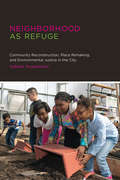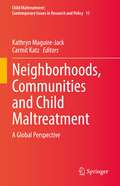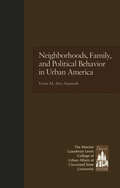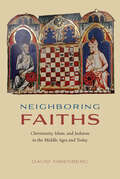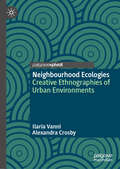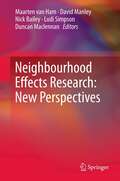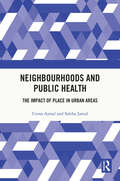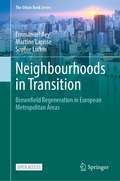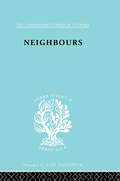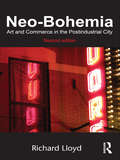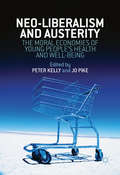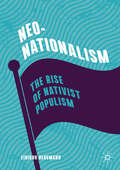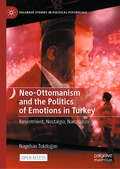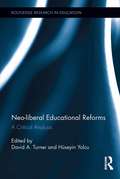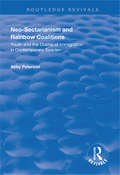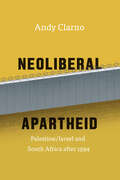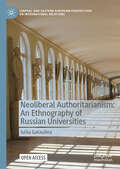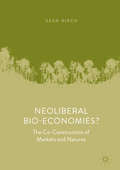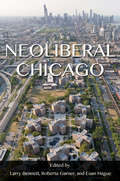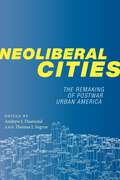- Table View
- List View
Neighborhood as Refuge: Community Reconstruction, Place Remaking, and Environmental Justice in the City (Urban and Industrial Environments)
by Isabelle AnguelovskiAn examination of environmental revitalization efforts in low-income communities in Boston, Barcelona, and Havana that help heal traumatized urban neighborhoods.Environmental justice as studied in a variety of disciplines is most often associated with redressing disproportionate exposure to pollution, contamination, and toxic sites. In Neighborhood as Refuge, Isabelle Anguelovski takes a broader view of environmental justice, examining wide-ranging comprehensive efforts at neighborhood environmental revitalization that include parks, urban agriculture, fresh food markets, playgrounds, housing, and waste management. She investigates and compares three minority, low-income neighborhoods that organized to improve environmental quality and livability: Casc Antic, in Barcelona; Dudley, in the Roxbury section of Boston; and Cayo Hueso, in Havana.Despite the differing histories and political contexts of these three communities, Anguelovski finds similar patterns of activism. She shows that behind successful revitalization efforts is what she calls “bottom to bottom” networking, powered by broad coalitions of residents, community organizations, architects, artists, funders, political leaders, and at times environmental advocacy groups. Anguelovski also describes how, over time, environmental projects provide psychological benefits, serving as a way to heal a marginalized and environmentally traumatized urban neighborhood. They encourage a sense of rootedness and of attachment to place, creating safe havens that offer residents a space for recovery. They also help to bolster residents' ability to deal with the negative dynamics of discrimination and provide spaces for broader political struggles including gentrification. Drawing on the cases of Barcelona, Boston, and Havana, Anguelovski presents a new holistic framework for understanding environmental justice action in cities, with the right to a healthy community environment at its core.
Neighborhoods, Communities and Child Maltreatment: A Global Perspective (Child Maltreatment #15)
by Carmit Katz Kathryn Maguire-JackThis volume explores methods for studying child maltreatment in the context of neighborhoods and communities, given their importance in the lives of families. It discusses the ways in which neighborhoods have changed over time and how this that has impacted parenting in the modern context. It also highlights the ways in which policies have contributed to persistent poverty and inequality, which indirectly impacts child maltreatment. An important focus of this volume is to examine the multitude of ways in which the neighborhood context affects families, including structural factors like poverty, segregation, residential instability, and process factors like social cohesion. The volume takes a critical look at the ways in which culture and context affect maltreatment through a community-based approach, and uses this approach to understand child maltreatment in rural areas. The editors and contributors explore innovative prevention approaches and reflect on the future of this field in terms of what remains unknown, how the information should be used to guide policy in the future, and how practitioners can best support parents while being mindful of the importance of context. Addressing an important topic, this volume is of relevance and interest to a wide readership of scholars and students in the social and behavioral sciences, as well as to practitioners and policy makers working with neighborhoods and communities.
Neighborhoods, Family, and Political Behavior in Urban America: Political Behavior & Orientations (Contemporary Urban Affairs)
by Yvette Alex-AssensohUndergirded by a multidisciplinary framework of political science, geography, and sociology, this book examines hte manner in which neighborhood economic resources and family structure shape individual political behavior among white and black citizens in urban America.
Neighboring Faiths: Christianity, Islam, and Judaism in the Middle Ages and Today
by David NirenbergEssays on how Jews, Muslims, and Christians have coexisted—or not—over the centuries, from “a particularly incisive and trustworthy historian of religion” (Commonweal).Christianity, Judaism, and Islam are usually treated as autonomous religions, but in fact across the long course of their histories the three religions have developed in interaction with one another. In Neighboring Faiths, David Nirenberg examines how Muslims, Christians, and Jews lived with and thought about each other during the Middle Ages and what the medieval past can tell us about how they do so today.There have been countless scripture-based studies of the three “religions of the book,” but Nirenberg goes beyond those to pay close attention to how the three religious neighbors loved, tolerated, massacred, and expelled each other—all in the name of God—in periods and places both long ago and far away. Nirenberg argues that the three religions need to be studied in terms of how each affected the development of the others over time, their proximity of religious and philosophical thought as well as their overlapping geographies, and how the three “neighbors” define—and continue to define—themselves and their place in terms of one another. From dangerous attractions leading to interfaith marriage; to interreligious conflicts leading to segregation, violence, and sometimes extermination; to strategies for bridging the interfaith gap through language, vocabulary, and poetry, Nirenberg aims to understand the intertwined past of the three faiths as a way for their heirs to produce the future—together.“Will be of extraordinary importance not only for specialists in the field but also for general readers and anyone interested in the relations among the three religions.” —Teofilo F. Ruiz, University of California, Los Angeles
Neighbourhood Ecologies: Creative Ethnographies of Urban Environments
by Ilaria Vanni Alexandra CrosbyThis book foregrounds socioecological stewardship in urban spaces. It demonstrates how activities like gardening and participating in events that spark ecological learning foster a sense of place, social connections, and lively neighbourhoods. Offering case studies from Sydney, Australia, it presents an innovative, interdisciplinary, place-based design research methodology. This approach combines ethnography to examine people-place-environment relationships with design’s potential for creating change through artefacts and initiatives like maps, curated walks, and workshops. The book contributes to methodological debates by showcasing how visual communication and socially engaged practices strengthen ethnographic understandings of society, culture, and the environment. The authors show that these practices connect everyday environmental actions to broader contexts, such as making cities liveable during climate change, aligning with the United Nations' Sustainable Development Goal 11: Sustainable Cities and Communities. Neighbourhood Ecologies offers key insights for scholars and students of urban sociology, human geography, anthropology, design studies, and social movement studies interested in how critical environmental issues become grounded in local contexts.
Neighbourhood Effects Research: New Perspectives
by Nick Bailey Duncan Maclennan Ludi Simpson Maarten Van Ham David ManleyOver the last 25 years a vast body of literature has been published on neighbourhood effects: the idea that living in more deprived neighbourhoods has a negative effect on residents' life chances over and above the effect of their individual characteristics. The volume of work not only reflects academic and policy interest in this topic, but also the fact that we are still no closer to answering the question of how important neighbourhood effects actually are. There is little doubt that these effects exist, but we do not know enough about the causal mechanisms which produce them, their relative importance in shaping individual's life chances, the circumstances or conditions under which they are most important, or the most effective policy responses. Collectively, the chapters in this book offer new perspectives on these questions, and refocus the academic debate on neighbourhood effects. The book enriches the neighbourhood effects literature with insights from a wide range of disciplines and countries.
Neighbourhoods and Neighbourliness in Urban South Asia: Subjectivities and Spatiality
by Sadan Jha and Dev Nath PathakThis volume examines urban South Asia through the ideas of neighbourhood and neighbourliness. With a focus on the affective socio-spatial and sensorial experiences of non-metropolitan, small and intermediate cities, the chapters in the volume look at neighbourhoods as a key to exploring the textures of urban life. Bringing together scholars from a variety of disciplines including sociology, anthropology, urban studies, planning, and social history, the book highlights urban heterogeneity and contemporary transformations in South Asia. It discusses the linkages between urban lived spaces and social life; memory, migration, and exile; and the city and its society through practices of everyday life in neighbourhoods. With studies from Sri Lanka, Nepal, Afghanistan, Bangladesh, and India, the volume addresses a wide range of issues pertaining to urban experiences in their regional specificities and in a broader context of the Global South. This book will be useful to scholars and researchers of urban sociology, anthropology, urban studies, planning and development, social history, political studies, cultural studies, geography, and South Asian studies. It will also interest practitioners and policymakers, architects, planners, civil society organisations, and thinktanks.
Neighbourhoods and Public Health: The Impact of Place in Urban Areas
by Saleha Jamal Uzma AjmalThis book examines the concept of neighbourhood over space and time and understands how neighbourhoods can impact human health and well-being. It discusses the identification of neighbourhood boundaries, features of individual neighbourhoods, and the concept of neighbourhood in some major world as well as Indian cities. Based on extensive research, this study refers to both primary as well as secondary sources of data using various statistical and geo-spatial techniques. The first section of the book focuses on the concept of neighbourhood, concept of neighbourhood unit, methods used in the identification of neighbourhood boundaries and theories related to neighbourhood effects on health. The subsequent section of the book deals with a case study on neighbourhood effects on health in an Indian city. The case study is followed by a comparison of its results with other global studies. This book will be useful to the departments of Geography, Public Health, Sociology and Social Work. It will also be of use to professionals and practitioners like city planners, architects, NGOs, Environmentalists, and urban policy makers.
Neighbourhoods in Transition: Brownfield Regeneration in European Metropolitan Areas (The Urban Book Series)
by Sophie Lufkin Emmanuel Rey Martine LapriseThis open access book is focused on the intersection between urban brownfields and the sustainability transitions of metreopolitan areas, cities and neighbourhoods. It provides both a theoretical and practical approach to the topic, offering a thorough introduction to urban brownfields and regeneration projects as well as an operational monitoring tool. Neighbourhoods in Transition begins with an overview of historic urban development and strategic areas in the hearts of towns to be developed. It then defines several key issues related to the topic, including urban brownfields, regeneration projects, and sustainability issues related to neighbourhood development. The second part of this book is focused on support tools, explaining the challenges faced, the steps involved in a regeneration process, and offering an operational monitoring tool. It applies the unique tool to case studies in three selected neighbourhoods and the outcomes of one case study are also presented and discussed, highlighting its benefits.The audience for this book will be both professional and academic. It will support researchers as an up-to-date reference book on urban brownfield regeneration projects, and also the work of architects, urban designers, urban planners and engineers involved in sustainability transitions of the built environment.
Neighbours and Nationals in an African City Ward
by David ParkinThis title is part of UC Press's Voices Revived program, which commemorates University of California Press’s mission to seek out and cultivate the brightest minds and give them voice, reach, and impact. Drawing on a backlist dating to 1893, Voices Revived makes high-quality, peer-reviewed scholarship accessible once again using print-on-demand technology. This title was originally published in 1969.
Neighbours:New Est Ils 114 (International Library of Sociology)
by Howard BraceyFirst published in 1998. Routledge is an imprint of Taylor & Francis, an informa company.
Neither Urban Jungle Nor Urban Village: Women, Families, and Community Development (Children of Poverty)
by Sara StoutlandFirst published in 1997. This is part of the Children of Poverty series, a collection of works on the effects of single parenthood, the feminisation of poverty and homelessness. This text looks at women, families and community development using case studies of tenant activists in Egleston Square and Boston.
Neo-Bohemia: Art and Commerce in the Postindustrial City
by Richard LloydNeo-Bohemia brings the study of bohemian culture down to the street level, while maintaining a commitment to understanding broader historical and economic urban contexts. Simultaneously readable and academic, this book anticipates key urban trends at the dawn of the twenty-first century, shedding light on both the nature of contemporary bohemias and the cities that house them. The relevance of understanding the trends it depicts has only increased, especially in light of the current urban crisis puncturing a long period of gentrification and new economy development, putting us on the precipice, perhaps, of the next new bohemia.
Neo-Liberal Urban Development in Post-Colonial Zimbabwe: Private Developers and the Emergence of Ruwa Town
by Terence Tapiwa MuzorewaThis book investigates the role of private land developers in the development of Ruwa Town in post-colonial Zimbabwe. Whereas other post-colonial established towns in the country emerged from direct public investment through the Growth Point policy, Ruwa emerged from a public-private partnership approach. The development of Ruwa Town is therefore a valuable example of a new post-colonial experience in urban planning and development, which is a clear departure from the colonial town planning which was premised on racial segregation. This book offers unique insights into the historical context, the role of private developers in the growth of the city, the impact of their involvement, bringing a comparative analysis with state-led development. It offers a valuable contribution to the field of urban studies, particularly within the context of urban development in post-colonial Zimbabwe and in Africa.
Neo-Liberalism and Austerity: The Moral Economies of Young People’s Health and Well-being
by Peter Kelly Jo PikeThis collection examines the relationships between a globalising neoliberal capitalism, a post-GFC environment of recession and austerity, and the moral economies of young people’s health and well-being. Contributors explore how in the second decade of the 21st century, many young people in the OECD/EU economies and in the developing economies of Asia, Africa and Central and South America continue to be carrying a particularly heavy burden for many of the downstream effects of the 2008-09 Global Financial Crisis. The authors explore the ways in which increasing local and global inequalities often have profound consequences for large populations of young people. These consequences are not just related to marginalisation from education, training and work. They also include obstacles to their active participation in the civic life of their communities, to their transitions, to their sense of belonging. The book examines the choices that are made, or not made by governments, businesses and individuals in relation to young people’s education, training, work, health and well-being, sexualities, diets and bodies, in the context of a crisis of neoliberalism and of austerity.
Neo-Nationalism: The Rise of Nativist Populism
by Eirikur BergmannThis book maps three waves of nativist populism in the post-war era, emerging into contemporary Neo-Nationalism. The first wave rose in the wake of the Oil Crisis in 1972. The second was ignited by the Collapse of Communism in 1989, spiking with the 9/11 terrorist attacks. The third began to emerge after the Financial Crisis of 2008, soaring with the Refugee Crisis of 2015. Whether the Coronavirus Crisis of 2020 will lead to the rise of a fourth wave remains to be seen. The book traces a move away from liberal democracy and towards renewed authoritative tendencies on both sides of the Atlantic. It follows the mainstreaming of formerly discredited and marginalized politics, gradually becoming a new normal. By identifying common qualities of Neo-Nationalism, the book frames a threefold claim of nativist populists in protecting the people: discursively creating an external threat, pointing to domestic traitors, and positioning themselves as the true defenders of the nation.
Neo-Ottomanism and the Politics of Emotions in Turkey: Resentment, Nostalgia, Narcissism (Palgrave Studies in Political Psychology)
by Nagehan TokdoğanThis open access book explores the politics of emotions under the ruling Justice and Development Party in Turkey and the leadership of President Recep Tayyip Erdoğan. It examines how emotional politics and, particularly, the use of a Neo-Ottomanist narrative created a new national mood and contributed to the durability of Erdoğan’s rule. The author analyses the interactions between national narratives, symbolic politics and emotions. She argues that these interactions have formed the basis of Erdoğan’s popular support for more than 20 years. The book is a valuable resource for scholars of political science and sociology, as well as policymakers interested in the rise of authoritarianism in Turkey.
Neo-Tribes: Consumption, Leisure And Tourism
by Andy Bennett Brady Robards Anne HardyThis collection brings together perspectives drawn from a range of international scholars who have conducted research into the applications of neo-tribal theory. The concept of the neo-tribe was first introduced by the French sociologist Michel Mafessoli (1996) to describe new forms of social bonds in the context of late modernity. This book critically explores the concepts that underpin neo-tribal theory, using perspectives from different disciplines, through a series of theoretically informed and empirically rich chapters. This innovative approach draws together a recently emergent body of work in cultural consumption, tourism and recreation studies. In doing so, the book critically progresses the concept of neo-tribe and highlights the strengths, weaknesses and the opportunities for the application of neo-tribal theory in an interdisciplinary way.
Neo-liberal Educational Reforms: A Critical Analysis (Routledge Research in Education)
by David A. Turner HThis volume gathers a cast of eminent scholars for a critical and comparitive analysis of how neoliberal education policies have functioned in a range of countries in different stages of economic development. Treating case studies from Europe, Asia, the Americas and the Middle East, the volume shows how globalization operates differently in different societal contexts.
Neo-sectarianism and Rainbow Coalitions: Youth and the Drama of Immigration in Contemporary Sweden (Routledge Revivals)
by Abby PetersonFirst published in 1997, this book examines the issue of racist and antiracist movements which are increasingly taking the stage in contemporary European societies in the face of a rapidly changing cultural landscape. The drama of immigration has been enacted by these movements with heightened intensity since the 1908s, and in particular the struggle is engaging the youth of Europe. In this book the author discusses the two sides of the antiracist movement in Sweden, on the one hand, the explosive sociality of the confrontation, a phenomenon she designates as neo-sectarianism, and on the other hand, the ephemeral sociality of ‘rainbow coalitions’ of non-confrontation, In focus is the participation of young people in the antiracist movement. It is an attempt by young people to not merely respond to perceived social changes and problems within society, but to actively participate in and shape society.
Neoliberal Apartheid: Palestine/Israel and South Africa after 1994
by Andy ClarnoIn recent years, as peace between Israelis and Palestinians has remained cruelly elusive, scholars and activists have increasingly turned to South African history and politics to make sense of the situation. In the early 1990s, both South Africa and Israel began negotiating with their colonized populations. South Africans saw results: the state was democratized and black South Africans gained formal legal equality. Palestinians, on the other hand, won neither freedom nor equality, and today Israel remains a settler-colonial state. Despite these different outcomes, the transitions of the last twenty years have produced surprisingly similar socioeconomic changes in both regions: growing inequality, racialized poverty, and advanced strategies for securing the powerful and policing the racialized poor. Neoliberal Apartheid explores this paradox through an analysis of (de)colonization and neoliberal racial capitalism. After a decade of research in the Johannesburg and Jerusalem regions, Andy Clarno presents here a detailed ethnographic study of the precariousness of the poor in Alexandra township, the dynamics of colonization and enclosure in Bethlehem, the growth of fortress suburbs and private security in Johannesburg, and the regime of security coordination between the Israeli military and the Palestinian Authority in the West Bank. The first comparative study of the changes in these two areas since the early 1990s, the book addresses the limitations of liberation in South Africa, highlights the impact of neoliberal restructuring in Palestine, and argues that a new form of neoliberal apartheid has emerged in both contexts.
Neoliberal Authoritarianism: An Ethnography of Russian Universities (Central and Eastern European Perspectives on International Relations)
by Iuliia GataulinaThis open access book delves into the politics of oppression and dispossession driven by global neoliberalism and state authoritarianism. Challenging liberal biases, it introduces the concept of "neoliberal authoritarianism," highlighting how the Russian state has transformed within the context of neoliberal globalization into a new state formation where authoritarianism is reinforced by neoliberal rationalities. The book analyzes neoliberal authoritarianism through an ethnographic lens on universities and their governance, which have become a new frontier of neoliberal economic development, serving the imperatives of growth and competition.
Neoliberal Bio-Economies?: The Co-Construction of Markets and Natures
by Kean BirchIn this book, Kean Birch analyses the co-construction of markets and natures in the emerging bio-economy as a policy response to global environmental change. The bio-economy is an economic system characterized by the use of plants and other biological materials rather than fossil fuels to produce energy, chemicals, and societal goods. Over the last decade or so, numerous countries around the world have developed bio-economy strategies as a potential transition pathway to a low-carbon future. Whether this is achievable or not remains an open question, one which this book seeks to answer. In addressing this question, Kean Birch draws on over ten years of research on the bio-economy around the world, but especially in North America. He examines what kinds of markets and natures are being imagined and constructed in the pursuit of the bio-economy, and problematizes the idea that this is being driven by neoliberalism and the neoliberalization of nature(s).
Neoliberal Chicago
by Euan Hague Larry Bennett Roberta GarnerThe neoliberal philosophy of fiscal austerity aligned with reduced regulation has transformed Chicago. As pursued by mayor Rahm Emanuel and his predecessor Richard M. Daley, neoliberalism led officials to privatize everything from parking meters to schools, gut regulations and social services, and promote gentrification wherever possible. The essayists in Neoliberal Chicago explore an essential question: how does neoliberalism work on the ground in today's Chicago? Contextual chapters explore race relations, physical development, and why Chicago embraced neoliberalism. Other contributors delve into aspects of the neoliberal vision, neoliberalism's impact on three iconic city spaces, and how events like the 2008 foreclosure crisis and the bid to attract the Olympic Games reveal the workings of neoliberalism. Contributors: Stephen Alexander, Larry Bennett, Michael Bennett, Carrie Breitbach, Sean Dinces, Kenneth Fidel, Roberta Garner, Euan Hague, Black Hawk Hancock, Christopher Lamberti, Michael J. Lorr, Martha Martinez, Brendan McQuade, Alex G. Papadopoulos, Rajiv Shah, Costas Spirou, Carolina Sternberg, and Yue Zhang.
Neoliberal Cities: The Remaking of Postwar Urban America (NYU Series in Social and Cultural Analysis #9)
by Thomas J. Sugrue Andrew J. DiamondTraces decades of troubled attempts to fund private answers to public urban problemsThe American city has long been a laboratory for austerity, governmental decentralization, and market-based solutions to urgent public problems such as affordable housing, criminal justice, and education. Through richly told case studies from Boston, Chicago, Cleveland, Los Angeles, New Orleans, and New York, Neoliberal Cities provides the necessary context to understand the always intensifying racial and economic inequality in and around the city center. In this original collection of essays, urban historians and sociologists trace the role that public policies have played in reshaping cities, with particular attention to labor, the privatization of public services, the collapse of welfare, the rise of gentrification, the expansion of the carceral state, and the politics of community control. In so doing, Neoliberal Cities offers a bottom-up approach to social scientific, theoretical, and historical accounts of urban America, exploring the ways that activists and grassroots organizations, as well as ordinary citizens, came to terms with new market-oriented public policies promoted by multinational corporations, financial institutions, and political parties. Neoliberal Cities offers new scaffolding for urban and metropolitan change, with attention to the interaction between policymaking, city planning, social movements, and the market.
